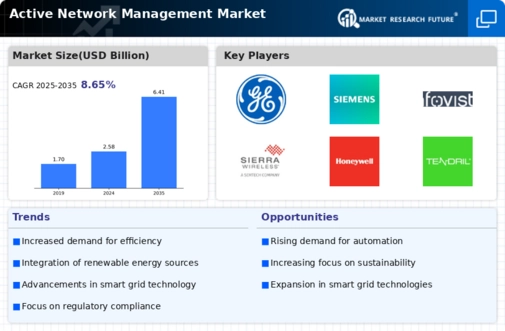Market Trends
Key Emerging Trends in the Active Network Management Market
The Active Network Management (ANM) market is experiencing transformative trends that highlight the increasing significance of efficient and responsive network management in today's dynamic energy landscape. One pivotal trend is the accelerated adoption of renewable energy sources and the integration of distributed energy resources (DERs) into power networks. ANM solutions are becoming essential for grid operators to balance the variable nature of renewable generation, manage grid congestion, and optimize the utilization of DERs. This trend aligns with the global push toward sustainable energy and the transition to a more decentralized and resilient power system.
The rise of smart grids and advanced metering infrastructure is another key driver shaping the ANM market. Smart grids enable real-time monitoring, control, and communication across the electricity grid, paving the way for more proactive and automated network management. ANM solutions leverage the data generated by smart grids to optimize energy flows, reduce losses, and enhance overall grid reliability. The integration of intelligent sensors, communication technologies, and analytics in smart grids is propelling the adoption of ANM as a crucial component of modern grid management strategies.
Moreover, the increasing complexity of electricity grids and the need for real-time decision-making are driving the trend of enhanced grid automation. ANM solutions play a vital role in automating control processes, enabling utilities and grid operators to respond rapidly to fluctuations in demand, unforeseen outages, and changes in generation patterns. The automation of grid operations not only improves efficiency but also enhances the grid's ability to adapt to dynamic conditions, supporting the integration of renewable energy and emerging technologies.
The electrification of transportation is influencing trends in the ANM market as well. The growing adoption of electric vehicles (EVs) introduces new challenges and opportunities for grid management. ANM solutions assist in mitigating the impact of EV charging on grid congestion by optimizing charging schedules, managing peak demand, and ensuring a balanced distribution of energy resources. As the demand for EVs continues to rise, ANM becomes a critical enabler for the seamless integration of electric transportation into existing power networks.
Additionally, the ANM market is witnessing a shift towards cloud-based solutions and advanced analytics. Cloud-based ANM platforms offer scalability, flexibility, and cost-effectiveness, allowing utilities to access powerful network management capabilities without the need for extensive on-premises infrastructure. Advanced analytics, including machine learning and predictive modeling, enhance the capabilities of ANM solutions by providing insights into future network behavior, enabling proactive decision-making, and improving the overall efficiency of grid operations.
Interoperability and standardization are emerging as important trends in the ANM market. As the number of devices and systems involved in grid management increases, ensuring seamless communication and integration between different components becomes essential. Industry stakeholders are working towards establishing standards and protocols to promote interoperability, enabling the smooth integration of ANM solutions with existing grid infrastructure and supporting a more collaborative and interconnected energy ecosystem.
The focus on resilience and grid reliability is influencing trends in the ANM market, particularly in the face of increasing cybersecurity threats and extreme weather events. ANM solutions contribute to grid resilience by providing real-time monitoring, rapid response capabilities, and adaptive management strategies to mitigate the impact of disruptions. As the frequency and severity of extreme weather events continue to rise, ANM becomes a critical tool for enhancing the resilience and reliability of energy networks.

















Leave a Comment